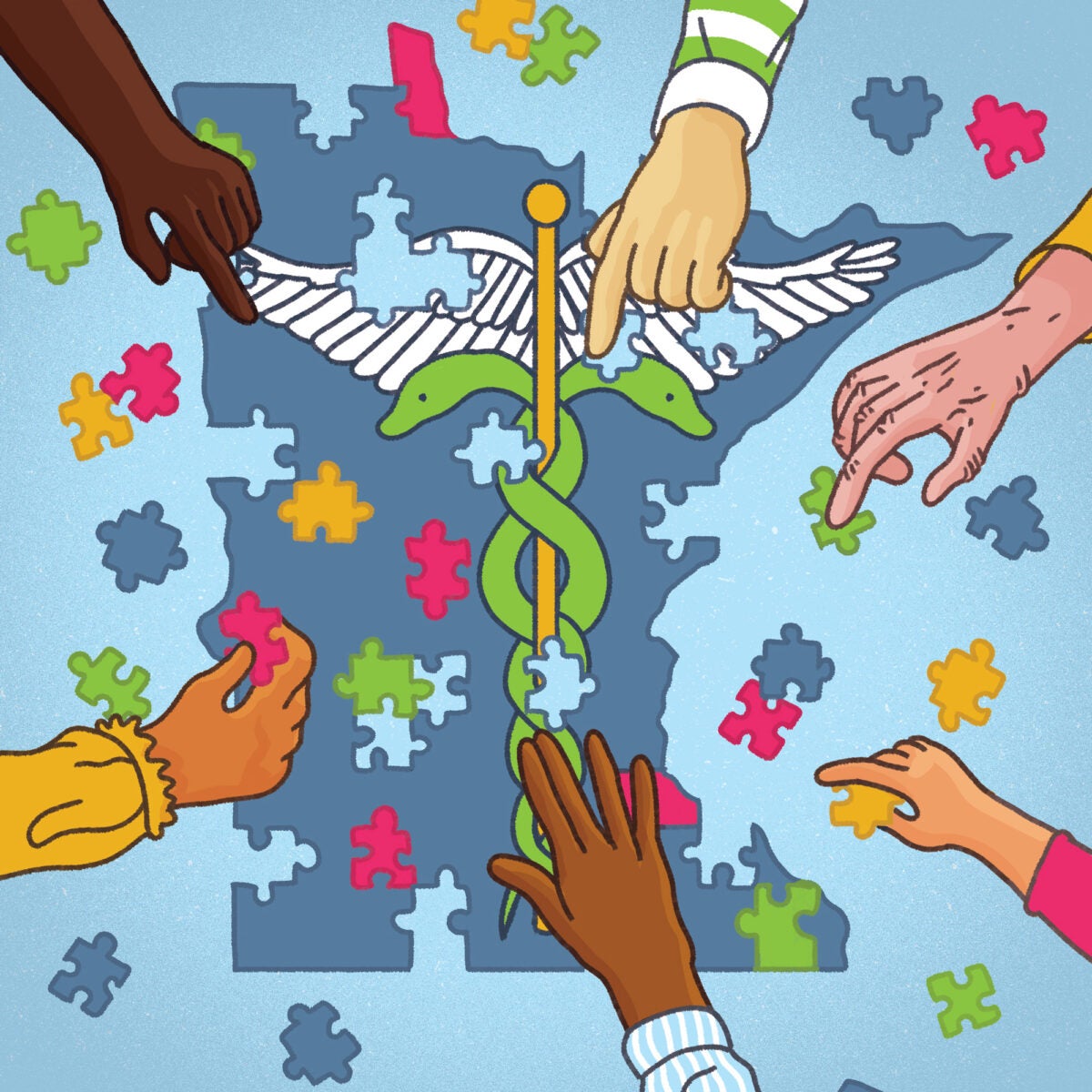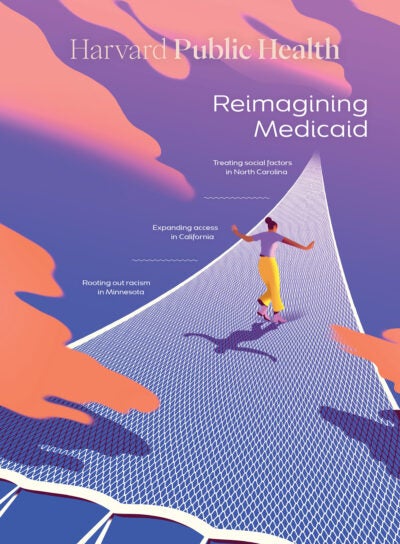
Feature
Can Medicaid solve the “Minnesota Paradox?”
As a physican, I work on two levels: the micro, which is what happens between me and a patient and their family in the clinic or hospital, and the macro, which is what I can do to inform and influence health policy at the community level. That dual role has been greatly influenced by my parents. My dad, who immigrated here from Cameroon, was a pharmacist, and my mom, a U.S. citizen born in Cameroon, was a nurse. Whenever we’d go to Cameroonian community gatherings in the Twin Cities, people would ask us questions about medications and treatments and how to navigate the health care system.

When I joined the state Medicaid office in 2020, those community voices echoed in my mind. I knew that communities of color are underresourced in terms of health care. Minnesota often tops lists of places with great health and educational attainment, but my review of more than a decade of data showed that within Medicaid, there are huge disparities in access and outcomes between White community members and our community members of color, particularly Black and American Indian. Described as “the Minnesota Paradox” by Samuel Myers, a professor in the Roy Wilkins Center for Human Relations and Social Justice at the University of Minnesota, these disparities affect everything from rates of asthma to access to COVID-19 vaccinations to maternal mortality.
There’s a clear reason for that: Our policies have been tuned to White Minnesotans. Black Minnesotans and American Indian Minnesotans have been more of an afterthought. For example, for years doctors have employed an algorithm that uses skin color to predict kidney health. The calculator scores Black patients as less sick than White patients with the same levels of kidney failure. The result: Black patients haven’t received the same level of care as White patients. We have centered White patients in other, less-obvious ways as well, like assuming that people have transportation for appointments and the ability to pay out-of-pocket costs. When they don’t, it leads to delays in care.
Sign up for Harvard Public Health
Delivered to your inbox weekly.
After reviewing the data and looking at Minnesota’s Medicaid policies, we began discussions in 2020 about how we could improve the health outcomes and lives of Minnesotans on Medicaid. We consulted resources from the Government Alliance on Race and Equity and we landed on a solution both simple and profound: listening to the communities most impacted by structural racism and involving them in decision-making about how health policy can better prioritize their well-being.
Working with the State Health Access Data Assistance Center, a program of the Robert Wood Johnson Foundation, we generated data to understand how Medicaid impacts communities in Minnesota differently along the lines of race. We used this to guide our choices about our communities of focus in our early work. The data was the signal, the thing that drew our attention. It’s the starting point—but it’s not the end point.
We saw that Black Minnesotans are significantly impacted by Medicaid, and by changes to it. We found that in Minnesota, 40 percent of Black adults, and 60 percent of Black children, get their health care coverage through Medicaid. Eighty percent of Black mothers and birthing persons get their health care coverage through us. And when we compared the health outcomes for people in our community who were born in the U.S. with outcomes for people born elsewhere, we saw significant disparities for U.S.-born Black Minnesotans.
Building on the shared understanding we created internally, we began a sustained conversation with Black community leaders in 2021. We acknowledged long-standing racial inequities that lead to racial health disparities—and Medicaid’s role in this disturbing status quo. We asked for community guidance on what our policy priorities and actions should be as part of developing our first report.
In those meetings, we provided a frame for understanding what Medicaid has control over (and what it doesn’t). We listened to participants’ priorities to figure out our next steps. And then, together with my colleagues at the Department of Human Services, we came up with a draft set of calls to action for Medicaid, and we took them back to the community. We organized another, broader set of community conversations with Medicaid enrollees, as well as officials and administrators from counties, managed care organizations, health care systems, clinics, and public health academics to get their input on these draft calls to action, and we incorporated all of that into our final report.
Our report included calls to action for three broad focus areas: increasing enrollment and eligibility, increasing access to culturally responsive care, and engaging directly and often with the people whom Medicaid serves. We named our office’s areas of accountability, such as advocating for a continuous eligibility policy; supporting enrollment navigators, who help eligible people get the insurance they need; and changing some of our infrastructure around community engagement.
In 2022, we shared the final report in multiple legislative hearings and with numerous community organizations and advocacy groups. We also organized a roundtable between Black community leaders and Lt. Gov. Peggy Flanagan to reflect on the priorities the report lifted up. We were happy to see Gov. Tim Walz and Flanagan include many of our calls to action in their budget proposal.
And we were happy our legislators took action: We now have laws that, starting in 2025, will keep eligible children on Medicaid from birth through age six without gaps in coverage. We have helped increase doula reimbursement rates, which we hope will increase access to culturally relevant perinatal care. And lawmakers cited our report in their successful proposals to increase state funding for enrollment navigators.
Many years ago, I went to a talk by a woman who said that equity can’t just be put up like wallpaper: We need to build it into the walls.
Our data show that our American Indian neighbors, many of whom are covered by Medicaid, also experience notable health disparities. We’re now meeting both with tribal nations and with urban American Indian community organizations in a very similar process with the goal of putting forward policies or structural changes that should be prioritized in order to improve the health and opportunity of American Indians on Medicaid in Minnesota.
Many years ago, I went to a talk by a woman who said that equity can’t just be put up like wallpaper: We need to build it into the walls. She inspired the frame I bring to my work as a physician and health care leader. I want us to do more than interrogate what we are doing to make things look better. I want us to ask: Are we actually getting to the underlying causes of why these inequities exist? Are we getting to the walls of the matter? Are we reconstructing them to avoid the disparities that we’ve seen? How can we imagine making policy differently so that it rebuilds those walls? This understanding was so crucial to our work that we named our iterative process, “Building Racial Equity into the Walls of Minnesota Medicaid.”
We’ve been able to make these advances because we focus on a set of questions that Medicaid leaders across the U.S. can ask. Whatever budget or policy proposal you’re working on, you should be asking: Do you have the data to see if there are any inequities? If you don’t, try to find the data—from academic institutions or government agencies, or by directly asking people who live and lead in communities impacted by the problem you see. Once you identify the inequities, that is your signal; it tells you whom you should be consulting with as you develop your problem statement and your intervention strategies. Don’t just sit at your desk and think, or read the literature; make sure that you are engaging with community members who are most impacted by the problem you’re looking at.
Our process was adapted in part from racial equity assessments and toolkits, including one from the Government Alliance on Race and Equity. It’s a good place to start for questions you can ask and next steps you can take. For example, there are folks who can help you navigate these conversations and help facilitate engagement from different communities.
This kind of work will encounter barriers. Sometimes you’ll hear, “We’re worried about disturbing precedent,” or “We’ve always done it this way.” But when we get that first bit of pushback, that discomfort, we don’t retreat. We need to find ways to push through the discomfort and challenge folks on how things are being done. And we need to be ready to be challenged.
It’s hard work to reimagine how we can use policy to create the collaborations across agencies and with communities that real change requires. But I also know it pays off. By funding continuous Medicaid coverage for kids, Medicaid navigators, and reimbursements for birth doulas, we have set the stage to start to dismantle the Minnesota Paradox and ensure that every Minnesotan has access to quality health care.
As told to Sheila Mulrooney Eldred, a freelance health journalist in Minneapolis.




